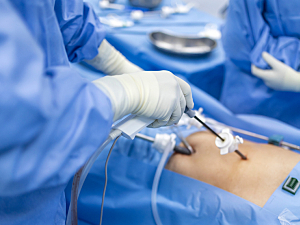Occult biliary disease is thought to explain 50% to 75% of cases of idiopathic acute pancreatitis (IAP), and a growing body of evidence supports operative management. In the first randomized trial of empiric cholecystectomy for IAP (published in 2015 in Annals of Surgery), laparoscopic cholecystectomy during initial admission was associated with a reduction of recurrence by two-thirds compared with watchful waiting.
IAP is still an emerging indication for empiric inpatient cholecystectomy, though. Researchers at Brigham and Women’s Hospital recently found an extremely low rate of adoption. In Surgery, they also report disparities in uptake by demographics and geography.
The authors are James C. Etheridge, MD, and Manuel Castillo-Angeles, MD, MPH, research fellows in the Department of Surgery; Molly P. Jarman, PhD, MPH, lead research faculty for Health Informatics and Data Infrastructure in the Center for Surgery and Public Health; Joaquim M. Havens, MD, director of Emergency General Surgery in the Division of Trauma, Burn and Surgical Critical Care; and a colleague.
Methods
The data source for the study was the National Inpatient Sample, which covers hospital discharges for 97% of the U.S. population. The researchers identified 62,305 patients who were hospitalized with IAP between October 2015 and December 2018.
Uptake of Cholecystectomy
Only 665 patients (1.1%) underwent cholecystectomy before discharge.
Predictors of Cholecystectomy
On multivariable analysis, the odds of undergoing cholecystectomy were higher for:
- Females (OR, 1.42; P=0.048)
- Latino/a/x patients (OR, 1.60; P=0.035 vs. white patients)
- Patients with private insurance (OR, 2.18; P=0.006 vs. public insurance)
- Patients treated in large hospitals (OR, 2.26; P=0.005 vs. small hospitals)
- Patients treated in urban teaching centers (OR, 2.22; P=0.032 vs. rural hospitals)
- Patients treated in urban non-teaching centers (OR, 3.09; P=0.003 vs. rural hospitals)
- Patients who needed total parenteral nutrition (OR, 2.70; P=0.020)
Opportunities to Improve Care
Joint guidelines of the International Association of Pancreatology and the American Pancreatic Association advise that neither ursodeoxycholic acid nor endoscopic retrograde cholangiopancreatography with sphincterotomy is nearly as effective as cholecystectomy for managing acute pancreatitis (published in Pancreatology).
Laparoscopic cholecystectomy is safe and of relatively low complexity, and broader uptake for treatment of IAP is warranted. Ongoing surveillance is warranted to ensure equitable access as the practice becomes more widely adopted.
